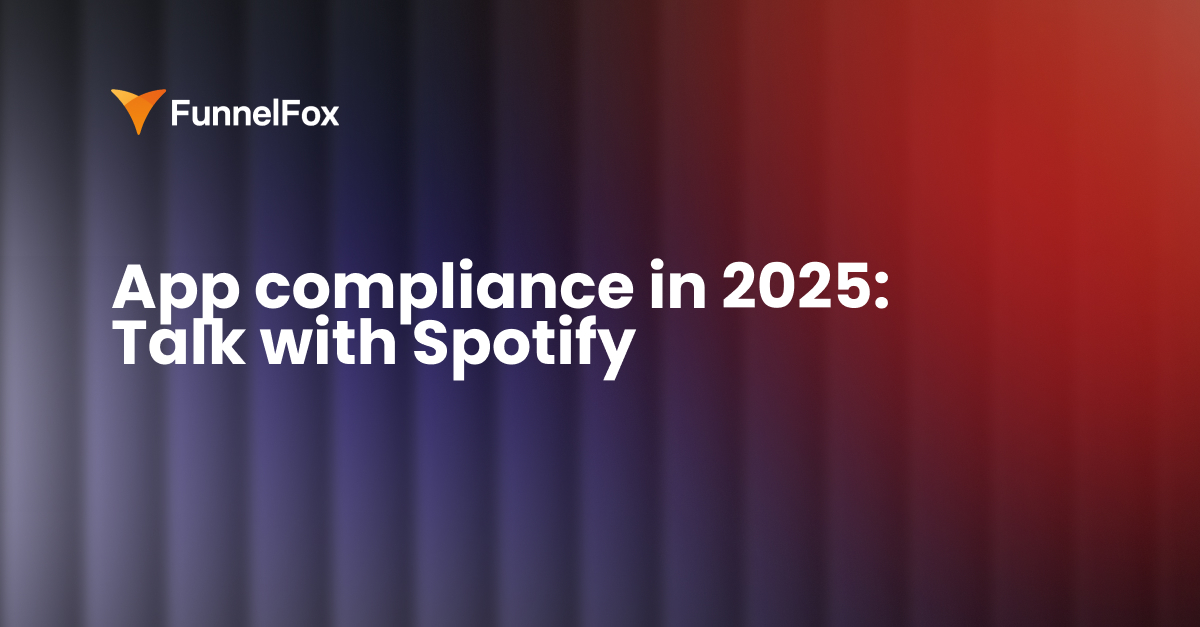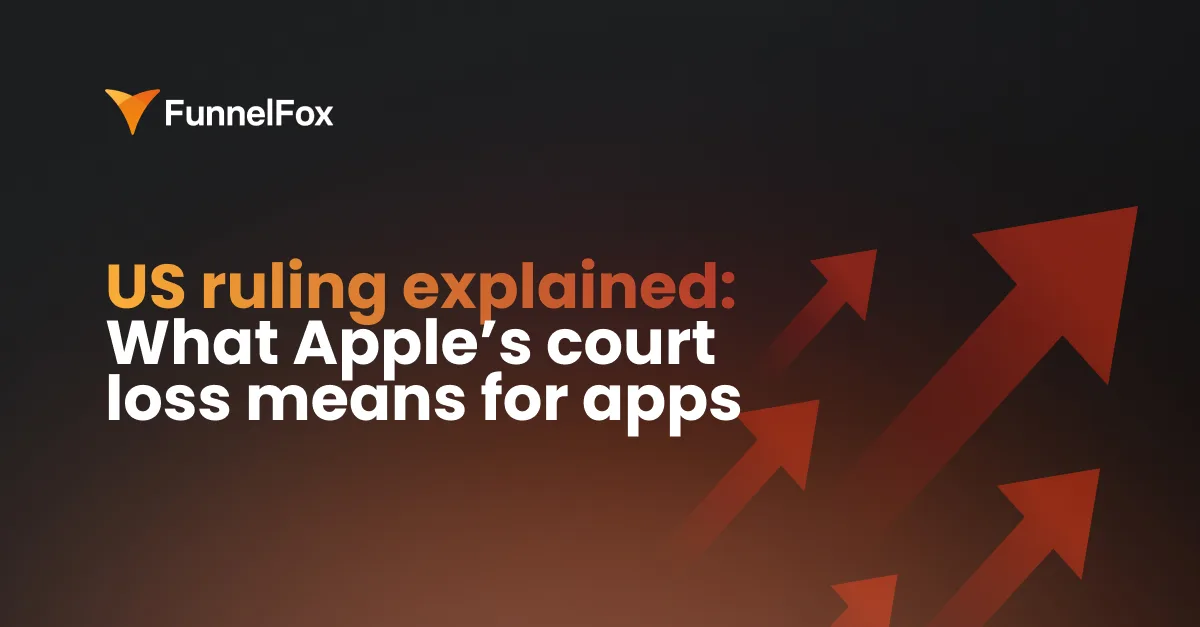App compliance used to be something legal dealt with. Now it shapes product roadmaps, pricing strategies, and even what kind of apps get funded.
Still, many teams treat it as background noise — something to think about later, or something that “mostly hits the big players.” That’s changing fast.
In a live session, Avery Gardiner, Director of Competition Policy at Spotify, joined Phil Carter, Founder & COO of Elemental Growth, and Andrey Shakhtin, CEO & Co-founder of FunnelFox, to discuss what the latest rulings mean for mobile apps.
They talked through how new rules are forcing product teams to rethink payments, how to implement web checkout without triggering rejection, what kind of conversion drop to expect (and avoid), how early-stage apps are affected, and what compliance might look like in 2025 and beyond.
Here’s what we learned.
The real impact of app stores
Most consumer apps today live in just two ecosystems: Apple’s App Store and Google Play. As Avery Gardiner said, “we’ve allowed something really weird to happen.” You buy an $800 phone, and you can only get apps from one place.
On iOS, that means Apple’s App Store — no alternatives. Google Play allows a bit more flexibility, but the vast majority of users still stick with the default store. And switching platforms just because of app store rules isn’t realistic for most people.
This lock-in gives platforms enormous control over what apps are allowed, how they monetize, and what they pay to operate. And the effects show up everywhere, especially in how commissions work.
Not all apps are treated the same
Only apps that sell digital goods pay Apple’s 15–30% cut. That doesn’t apply to apps selling physical products, running marketplaces, or offering human services.
For teams building subscriptions, education tools, or content platforms, that double standard isn’t just frustrating — it defines what’s viable and what’s not.
What store commissions really cost developers
Phil Carter put it simply: if you’re doing $1–10M in ARR, giving up 30% can stop you from ever reaching escape velocity. Even if you’re in the Apple Small Business Program and paying 15%, that’s still a huge hit to your unit economics.
For some teams, it doesn’t even get that far. Investors see the margins and walk away before the product ships.
When the rulemaker is also your competitor
Apple and Google set the terms — they decide what gets approved, how long it takes, and what users see in search. For smaller teams, that adds friction at every stage.
Stores also run their own apps, which compete directly with yours.
As Avery warned, “we know what happens in economies when you have those sorts of conditions. They’re monopolists who abuse their power.”
The rules just changed, and more changes are coming
For years, app stores made the rules, and everyone else just worked around them. That’s starting to change.
In the U.S., a court ruling now allows developers to add buy buttons that link to external payment options that Apple had blocked for years. Spotify acted fast: on April 30, they submitted an app update with in-app pricing and a direct link to purchase Premium on the web.
In the EU, Apple was found in violation of the Digital Markets Act. Regulators called out Apple’s use of “scare screens” — design patterns meant to steer users away from using external payment flows. The company was given 30 days to address it.
Other markets are picking up too. The UK is drafting new rules expected this fall, with signs that app stores could be formally designated as strategic gatekeepers, which could trigger more structural changes. Japan, Brazil, South Korea, and Australia are moving in similar directions.
What the future might look like
Alternative app stores
New stores are one of the most obvious next steps. Some could be broad (like Amazon expanding its store on Android), others might be tightly focused:
- curated stores for kids’ apps
- vertical stores for games or professional tools
- region-specific stores with local rules and pricing
Each could bring its own policies, standards, and priorities, giving developers real choices for the first time.
Competing on more than reach
If alternatives emerge, platforms may start to compete on things beyond distribution scale — think of security, privacy, UX, and design standards. That opens the door for quality-focused stores, which the current system doesn’t reward.
A more open mobile OS
Avery Gardiner raised the question directly: why can you install software from anywhere on a MacBook, but not on an iPhone?
Early experiments: How teams are testing external payments
Spotify became one of the first to push a live update with external pricing and a buy button. The app now shows users real prices and links them out to purchase Premium directly, without Apple’s in-app payment system.
Other teams are testing similar flows using tools like RevenueCat or custom setups. Some are using price comparisons or clear opt-in links to encourage users to choose web checkout over native.
Cameo, for example, now offers two payment options — in-app or on the web — with a visible price difference. That gives users a real choice and lets the team shift volume without hiding the tradeoff.
What early data shows
The early data is mixed. In some A/B tests shared by Phil Carter, conversion dropped by 25–45% when users were pushed to a browser flow.
But he emphasized that not all flows are equal: teams with clear messaging, strong value props, or prefilled pricing are seeing better numbers.
Getting started is hard, but necessary
The shift to external payments isn’t plug-and-play. Teams face legal questions, UX tradeoffs, and tight review processes. But as more rules change, the message is clear: waiting it out is no longer the safer path.
Spotify led by example. Google is also rolling out developer-defined billing on Android, offering users a choice at checkout.
The UX gap is still real. As Phil noted, conversion can drop sharply, especially on iOS, where users are used to native, fluid payment flows. Teams are now iterating on copy, visual cues, and placement, trying to reduce friction and keep users on track. It’s not seamless yet, but it’s the clearest picture we’ve had of what app payments might look like without platform restrictions.
Practical tips for product teams
Shipping an external buy button is a cross-functional project that touches legal, UX, compliance, and payments. To make it work, teams need to be intentional about both how it’s implemented and who’s involved.
Start with UX and risk
Make the flow as clear as possible: show real pricing before the redirect, explain what’s about to happen, and keep the visual transition smooth. Avoid tricks or misdirection — they may lead to rejection in app review.
On the legal side, check both local laws and platform-specific policies. In the U.S., some changes are already in effect. In the EU, more are coming. But gray areas still exist, especially around how you frame and position external links.
Get the right people in the room
Successful launches involve more than just a PM and an engineer. You’ll likely need:
- a product owner to coordinate the rollout
- a designer to handle user flow, edge cases, and visual clarity
- a lawyer (in-house or external) to review compliance
- and in many cases, a tax expert, especially if payments cross borders
Use SaaS tools where it makes sense
Many teams aren’t ready to build global compliance from scratch. Instead, they’re using tools like:
- Merchant of Record platforms to handle payments, taxes, and risk
- compliance-as-a-service tools to stay in line with evolving rules
These setups won’t solve everything, but they help teams move faster and reduce risk.
How Spotify works with regulators
Spotify is actively helping shape the rules behind the scenes. Avery Gardiner described the company’s strategy as deeply engaged on multiple fronts. They’ve testified before Congress, worked with the FTC, and collaborated with the European Commission. The goal is to modernize platform regulation so it reflects how digital markets really work.
Spotify is also a founding member of the Coalition for App Fairness — an industry group that includes Epic Games, Deezer, and others advocating for more balanced platform rules.
In the U.S., they’ve backed a bipartisan bill led by Rep. Cathy McMorris Rodgers that would ban self-preferencing by dominant platforms — one of the biggest pain points in app discovery and distribution.
This kind of work doesn’t produce overnight wins. But it creates momentum (and political cover) for product teams to start testing new flows, even before every rule is finalized.
Global momentum is building
What’s happening in the U.S. and Europe isn’t isolated. Other countries are watching closely, and many are moving in the same direction.
Japan, Brazil, South Korea, and Australia have all opened investigations or introduced laws aimed at rebalancing platform power. Many countries are focusing on app store commissions and whether dominant platforms give unfair advantages to their own services.
According to Avery Gardiner, regulators are starting to coordinate more closely, sharing data and looking for patterns. When one country moves, it can validate or accelerate progress elsewhere.
That doesn’t mean a single global rulebook. But it does mean that product and legal teams can start to spot common themes and plan for a future where app distribution looks very different from today.
What’s next
No one wants more red tape. The real goal of all this change is to remove friction, not add it. If regulation does its job, it can unlock new space for innovation, better pricing for users, and real competition for the first time in over a decade.
But change doesn’t just happen at the policy level. Avery emphasizes that laws can’t move forward unless teams are actively testing new models and putting them on the record.
Phil Carter made a similar point: teams need to treat this moment like a product challenge. That means running real A/B tests, tracking conversion, and iterating based on real user behavior.
There’s no single playbook yet, but there’s a window opening. For now, the advice is clear: start small, stay within the rules, and keep learning.









